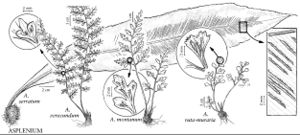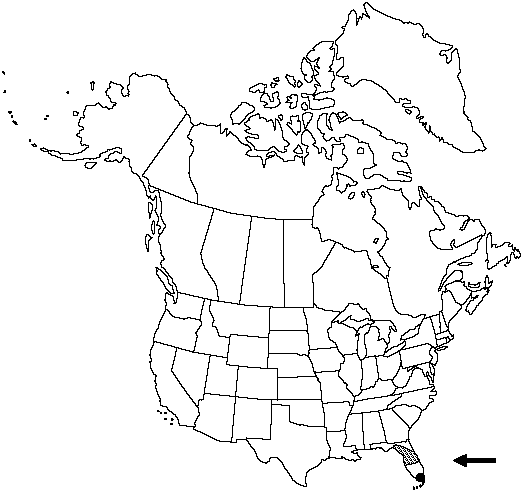Asplenium verecundum
Bull. Torrey Bot. Club 33: 193. 1906.
Roots proliferous. Stems erect, unbranched; scales blackish throughout, linear to narrowly triangular, 0.9–1.3 × 0.1–0.4 mm, margins entire. Leaves monomorphic. Petiole brownish black, 0.5–3 (–5) cm, 1/9–1/7 length of blade; indument of blackish, linear-lanceolate scales at base. Blade narrowly lanceolate, 2–3-pinnate, (4–) 10–20 (–) 30 × 1–3 (–5) cm, thin, glabrous; base tapered somewhat; apex formed by gradual reduction, not rooting. Rachis blackish brown, dull, essentially glabrous. Pinnae in (8–) 12–16 (–22) pairs, oblong; medial pinnae 0.5–2.5 × 3–10 mm; base cuneate; apex obtuse. Pinnules of 1–5 segments; segments oblanceolate, 2–3 × 1–2 mm, entire; apex mostly round. Veins free, evident, 1 per segment. Sori 1 per segment. Spores 64 per sporangium. 2n = 144.
Habitat: Limestone outcrops in grottoes, on cliffs, and on boulders in shaded woods
Elevation: 0–50 m
Discussion
This delicate spleenwort, Asplenium verecundum, occurs in both southern and central peninsular Florida where it is very local. Sterile hybrids are known to result from crossing with A. trichomanes-dentatum (A. × biscayneanum) and A. abscissum (A. × curtissii).
Asplenium verecundum may be a variety or cytotype of the similar A. myriophyllum (Swartz) C. Presl of the West Indies (D. B. Lellinger 1985).
Selected References
None.
Lower Taxa
"[-]30cm" is not declared as a valid unit of measurement for this property.No values specified."/9lengthofblade" is not declared as a valid unit of measurement for this property.

